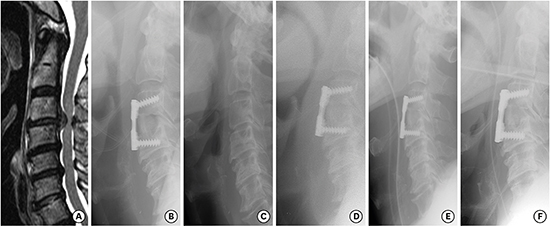INTRODUCTION
METHODS
Statistical analysis
RESULTS
 | Fig. 1Radiological features of the patient with reintubation after ACSS. (A) A 73-year-old male patient (case No. 9) showing herniated intervertebral disc C3–C4 with severe spinal cord compression on sagittal MR imaging. Anterior cervical discectomy C3–C4 and fusion using iliac bone graft was performed. Extubation was conducted on the day of operation as the patient has no respiratory distress and immediate postoperative plain lateral X-ray revealed (B) only mild prevertebral soft tissue swelling compared to (C) preoperative film. (D) On postoperative day 4, the patient began complaining of difficult breathing and plain lateral X-ray showed markedly increased prevertebral soft tissue swelling. (E) We decided to reintubate the patient to protect the airway patency. (F) The patient was intubated for 4 days and extubated on postoperative day 8. The patient was discharged from hospital on postoperative day 14 without any further respiratory distress.ACSS = anterior cervical spine surgery, MR = magnetic resonance.
|
 | Fig. 2Radiological features of the patient with prolonged intubation due to cervical hematoma after ACSS. (A) A 52-year-old female patient (case No. 4) showing herniated intervertebral disc C5–C6, C6–C7 right on sagittal MR imaging. Anterior cervical discectomy C5–C6, C6–C7 and fusion using Solis cage with polybone were performed. Immediate postoperative plain lateral X-ray showed (B) mild prevertebral soft tissue swelling compared to (C) preoperative film. Prolonged intubation was decided to protect airway patency. (D) On postoperative day 1, the patient showed desaturation with severe anterior neck swelling and increased soft tissue swelling at the operation level on plain lateral X-ray. (E) Contrast enhanced neck CT scan revealed hematoma (marked in yellow circle) compressing trachea to the left side. Emergent hematoma evacuation was followed and injured right thyroid artery was noted. (F) Immediate postoperative plain lateral X-ray showed much decreased prevertebral soft tissue swelling. Extubation was conducted 4 days after hematoma evacuation. The patient was discharged from hospital on postoperative day 10 without any respiratory complication.ACSS = anterior cervical spine surgery, MR = magnetic resonance, CT = computed tomography.
|
Table 1
Clinical data of 11 patients whom required prolonged intubation or reintubation

Table 2
Analysis of characteristics and outcomes for patients after ACSS

Table 3
Association between prolonged intubation (≥ 24 hours) and reintubation with clinical risk factors using univariate and multivariate linear regression model





 PDF
PDF Citation
Citation Print
Print




 XML Download
XML Download